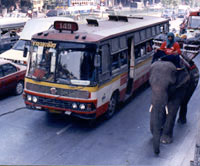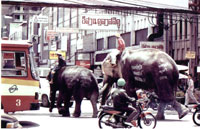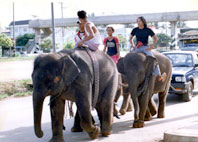Bangkok's Elephants
I decided to write this article on Friday night. Here is why. I got stuck at one of Bangkok’s most ridiculous intersections. It is here that five major roads meet under an overpass. The street vendors know that this is a real hot spot. Not only do cars get stuck there for up to fifteen minutes, but the overpass protects them from the rain. I sat in the car as flower, newspaper, fruit, and peanut vendors all peered into my window hoping for a sale.
Then came the elephant. A gigantic male elephant walking down one of Bangkok’s major traffic arteries with one rider and two people accompanying him on foot. The elephant was so out of place that perhaps an alien landing would have caused me less shock. Elephants are always out of place in Bangkok, but on this particular intersection, it was even more pronounced. Then my greatest fear came true. The humans decided the elephant was going to cross this intersection when their light was not even green. Yikes.
The two people on foot simply stepped out in front of the zooming traffic, making it stop by frantically waving their hands. The elephant proceeded through the intersection. He almost got run over by a gigantic tour bus that could not have possibly braked in time. Close call. He went through the rest of the intersection in a hurry and turned right.
simply stepped out in front of the zooming traffic, making it stop by frantically waving their hands. The elephant proceeded through the intersection. He almost got run over by a gigantic tour bus that could not have possibly braked in time. Close call. He went through the rest of the intersection in a hurry and turned right.
I watched in total fear as the elephant and the people with it walked along the very edge of this busy highway. There was a guardrail forcing them to stay on the pavement. Friday night chaos traffic went flying by missing collision after collision by centimetres. One very unhappy elephant indeed. Poor guy. They had not even bothered to attach some reflectors to the elephant’s tail or legs.
Having elephants within Bangkok city limits became illegal in February 2000. Obviously to no avail. This elephant had a pack slung over his back. He was working. His job? To sell the bananas on his back, which are there so he can eat, to tourists or locals and to make good money for his owner. The current elephant problem is all about money. Aren’t most things?
An elephant costs between 100,000 to 300,000 baht (2,500-7,500 US dollars) although old, overworked, or drug-addicted elephants can be had for much cheaper. Yes, it’s true; some unscrupulous owners feed their elephants amphetamines to make them more productive. Then it is up to the elephant not only to make enough money to feed his owner, but to pay off his purchase price, and feed him or herself as well. Not an easy task at all.
make good money for his owner. The current elephant problem is all about money. Aren’t most things?
An elephant costs between 100,000 to 300,000 baht (2,500-7,500 US dollars) although old, overworked, or drug-addicted elephants can be had for much cheaper. Yes, it’s true; some unscrupulous owners feed their elephants amphetamines to make them more productive. Then it is up to the elephant not only to make enough money to feed his owner, but to pay off his purchase price, and feed him or herself as well. Not an easy task at all.
An elephant working in a field can only make about 60 baht a day (1.25 US dollars). When the seasonal ploughing job or tourist gig is finished the elephant gets to hoof it to Bangkok to work some more because an elephant hustling the streets of Bangkok can pull in 800 baht (20 US dollars) a night or more. Temptation prevails for the owner but the elephant is definitely getting the bad end of the bargain.
Elephants in Bangkok are highly symbolic of man’s clash with nature. As forests grow smaller, food supplies fall short, elephant work grows scarce, elephants wander into plantations to eat what is not “rightfully” theirs, and overworked, abused, angry elephants attack and kill people, the problem emphasizes itself. What to do with Thailand’s 2,705 domestic and 1,975 wild elephants? It leaves everyone scratching his or her head.
symbolic of man’s clash with nature. As forests grow smaller, food supplies fall short, elephant work grows scarce, elephants wander into plantations to eat what is not “rightfully” theirs, and overworked, abused, angry elephants attack and kill people, the problem emphasizes itself. What to do with Thailand’s 2,705 domestic and 1,975 wild elephants? It leaves everyone scratching his or her head.
Elephants still are the national symbol of Thailand although the elephant is no longer displayed on its flag. There is a great love and respect for these animals but they have lost their traditional function over time. They no longer carry warriors into battle. There are more efficient forms of transport. Logging was banned in 1987. Thailand’s old friend is somehow turning into a foe at no fault of the elephant. Although I understand why the elephants come to Bangkok to work, it does not make seeing them any easier.
What to do when faced with a hungry and overworked elephant on a Bangkok street? It is only natural to want to feed it. I am guilty of doing this in the past but I have decided to stop. In my opinion, its better to go take an elephant ride with a reputable elephant camp or go see an elephant show. Somehow seeing an elephant dressed up and performing tricks seems ludicrous too, but it beats having them walk the city streets while tour busses whiz by.
There are foundations that have been set up to help the elephants get off the streets and back into the jungle. Elephants need land and money, but they are not the only ones in today’s overcrowded and often struggling world. Thailand is indeed making efforts to help the elephant but will it be enough and will it be in time? The elephant I saw Friday night certainly wants to know.
To learn more about the plight of elephants in Thailand, you may wish to look at Asian Elephant Foundation of Thailand http://www.aeft.org/ or Friends of the Asian Elephant http://www.elephant.tnet.co.th/.
